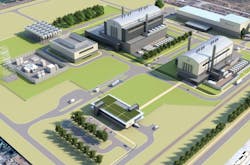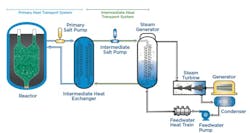TVA Agrees to Host Kairos SMR Nuclear Plant to Power Google Data, AI Operations by 2030
Small modular reactor designer Kairos Power is committing to building a new SMR nuclear power plant in a deal that includes the Tennessee Valley Authority (TVA) and tech giant Google.
The deal announced this week would be a power purchase agreement to create new generation capacity for Google data centers on the TVA system in Tennessee and Alabama. The planned Kairos Power Hermes 2 plant in Oak Ridge, Tennessee, would initially deliver up to 50 MW of carbon-free and baseload power into the system to fortify the grid for increased data center and artificial intelligence (AI) load.
Predictions of AI future spurring load growth prospects
No SMR nuclear plants have been built or operated in the U.S. as of yet, but Hermes 2 could be the first under Kairo’s original long term PPA with TVA to bolster Google’s capacity needs. The deal eventually could put about 500 MW of new, advanced reactor projects into motion into the 2030s.
A predicted 125 GW of future AI and data center additional capacity is motivating tech companies such as Amazon, Microsoft, Oracle and Google to seek out nuclear energy for its baseload and carbon-free attributes.
“To power the future, we need to grow the availability of smart, firm energy sources,” said Amanda Peterson Corio, Google’s Global Head of Data Center Energy, in a statement. “This collaboration with TVA, Kairos Power, and the Oak Ridge community will accelerate the deployment of innovative nuclear technologies and help support the needs of our growing digital economy while also bringing firm carbon-free energy to the electricity system.
“Lessons from the development and operation of the Hermes 2 plant will help drive down the cost of future reactors, improving the economics of clean firm power generation in the TVA region and beyond,” Corio added.
Both the Biden and Trump presidential administrations have called for increased nuclear capacity to bridge goals of both environmental sustainability and grid resiliency. Recently, the U.S. Department of Energy created a pilot program to accelerate advanced reactor development and selected 10 companies to try developing a project to achieve criticality by next July 4. Kairos Power is not among those companies in the DOE pilot.
“The deployment of advanced nuclear reactors is essential to U.S. AI dominance and energy leadership," said Energy Secretary Chris Wright in a statement. “The Department of Energy has assisted Kairos Power with overcoming technical, operational, and regulatory challenges as a participant in the Advanced Reactor Demonstration Program, and DOE will continue to help accelerate the next American nuclear renaissance."
Google has data centers in Montgomery County, Tennessee, and Jackson County, Alabama. Kairos Power hopes to start operations on the Hermes 2 reactor by 2030, although construction has yet to commence.
SMR nuclear advocates say that developing smaller reactors with passive safety features will offer a faster and less expensive nuclear project than conventional build-outs such as the Vogtle 3 and 4 expansions in Georgia.
Corporate first to back SMR nuclear
The Kairos Power design is a Generation IV reactor and is designed with molten salt coolant. It would be the first non-water-cooled reactor design approved for construction in the U.S. over the past 50 years.
Google says its deal is the first corporate agreement to purchase nuclear energy from a small modular reactor developer.
“The grid needs new electricity sources to support AI technologies that are powering major scientific advances, improving services for businesses and customers, and driving national competitiveness and economic growth,” reads Google’s statement announcing its original deal with Kairos in October 2024.
“Nuclear solutions offer a clean, round-the-clock power source that can help us reliably meet electricity demands with carbon-free energy every hour of every day,” the Google announcement added.
Earlier this year, Google announced a partnership with Elementl Power to determine locations for advanced nuclear and SMR nuclear sites to power its fleet of data centers. The company committed early-stage development capital on advance work for three proposed projects under the Elementl deal.
Nuclear reactors have powered electricity plants and U.S. Navy submarines for more than 70 years. The U.S. currently utilizes a conventional fleet of 94 nuclear energy units meeting about 18% of the nation’s utility-scale electricity generation.
These plants also account for close to half of the overall carbon-free power generated nationwide.
About the Author
Rod Walton, EnergyTech Managing Editor
Managing Editor
For EnergyTech editorial inquiries, please contact Managing Editor Rod Walton at [email protected].
Rod Walton has spent 17 years covering the energy industry as a newspaper and trade journalist. He formerly was energy writer and business editor at the Tulsa World. Later, he spent six years covering the electricity power sector for Pennwell and Clarion Events. He joined Endeavor and EnergyTech in November 2021.
Walton earned his Bachelors degree in journalism from the University of Oklahoma. His career stops include the Moore American, Bartlesville Examiner-Enterprise, Wagoner Tribune and Tulsa World.
EnergyTech is focused on the mission critical and large-scale energy users and their sustainability and resiliency goals. These include the commercial and industrial sectors, as well as the military, universities, data centers and microgrids. The C&I sectors together account for close to 30 percent of greenhouse gas emissions in the U.S.
He was named Managing Editor for Microgrid Knowledge and EnergyTech starting July 1, 2023
Many large-scale energy users such as Fortune 500 companies, and mission-critical users such as military bases, universities, healthcare facilities, public safety and data centers, shifting their energy priorities to reach net-zero carbon goals within the coming decades. These include plans for renewable energy power purchase agreements, but also on-site resiliency projects such as microgrids, combined heat and power, rooftop solar, energy storage, digitalization and building efficiency upgrades.



